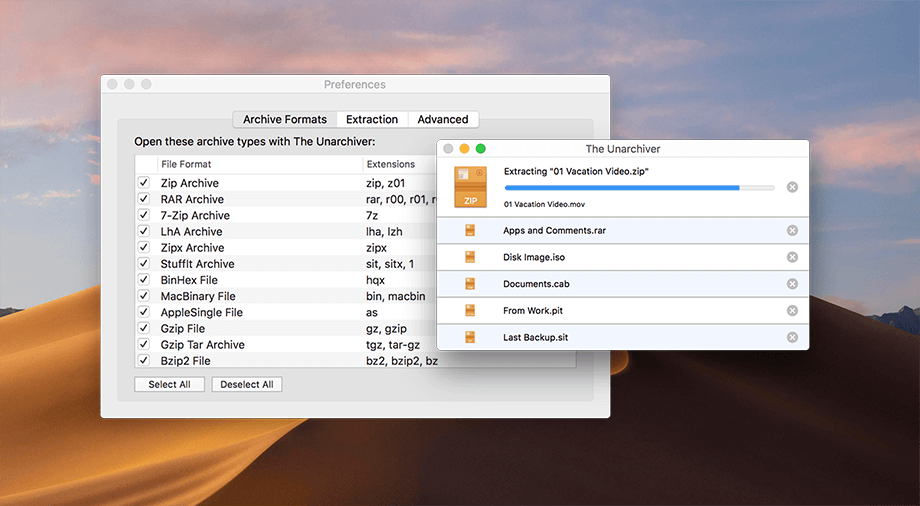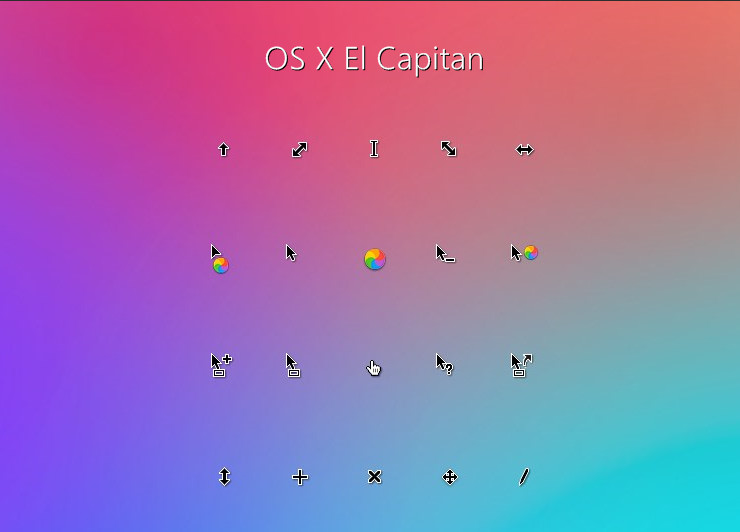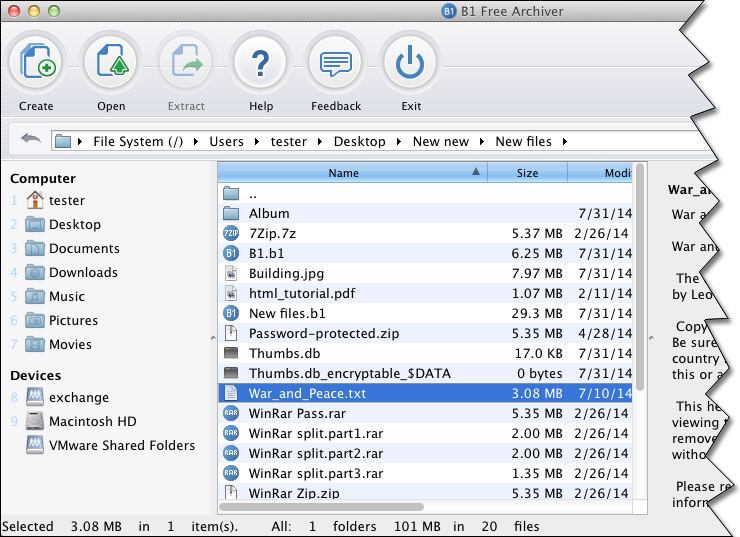Unzip RAR by unziprar.com is a freeware application that was designed to help you easily and quickly extract the contents of your RAR archives. Even though there is no version of Unzip RAR for Mac available on the Internet, there are plenty of other tools that you can use to open RAR archives on Mac. The first step is to open Terminal. Use the 'cd' command to change the directory to the location where you want to unzip the zip file. For example you can use: cd./Desktop. The next step is to invoke the unzip command. Type the following into Terminal. This assumes you have a zip file ready to unzip. Mac users interested in 7 zip for mac 10.6.8 generally download: WinZip Mac 2.0 Compress your data into ZIP archives, protect them with a password, and share them via email.
Terminal
Hey
Terminal, the wonder app, can do pretty much anything. This post is going to show you how you can unzip files using Terminal. I will also show you how you can can combine commands to download and unzip files really quickly. Its really simple to complete. You may want to use Terminal since you can access extra options which you may normally be hidden away from you.
The first step is to open Terminal. Use the 'cd' command to change the directory to the location where you want to unzip the zip file. For example you can use:
cd ./Desktop
The next step is to invoke the unzip command. Type the following into Terminal. This assumes you have a zip file ready to unzip.
unzip file.zip
This will unzip you file into you desktop location. If you want to change this location you can type the following.
unzip file.zip -d ~/another/folder
You can also remove all of the text that Terminal will output when you run the command by adding a modifier/option to the front of the syntax.
unzip -q file.zip

Optionally you can also add more information by adding a verbose option. This will show you all of the details of the file you unzip.
unzip -v file.zip
You can combine this command with other command so you can download and unzip a file automatically. For example if you have wget installed you can type in Terminal.
cd ~/download;wget http://www.example.com/file/zip;unzip file.zip
The different commands are separated by a semi-colon (;). The previous command will change your directory to your downloads folder. It will then grab the zip file from your website and unzip the file to your location.
The one problem with unzip command is that it creates a an extra folder called '__MACOSX' this folder would normally be hidden as it stores extra data that you don't need to see. You can easily get rid of this by combining the delete command with the unzip command.
unzip file.zip;rm -rf __MACOSX
That will unzip the file and then delete this extra folder. You can of course combine this with the download command previously.
cd ~/download;wget http://www.example.com/file/zip;unzip file.zip;rm -rf __MACOSX
You could even take this further by moving files and folders although that would be out of the scope of this article. How quick do you reckon it would be to type that command compared to downloading a zip folder normally and then normally extracting it. You do have to type more, but it is a lot less clicking and searching in Finder.
If you want to take your skills with Terminal a bit further I recommend you check out the Terminal Category on this site. If you fancy reading a book there is a couple on Amazon that I regularly see mentioned and recommend, O'reilly Unix Geeks and Unix Under the Hood both are designed for Mac OS X and take Terminal further.
PlayerXtreme was designed with the idea that Videos and Movies should be easy to play and available on all devices across your home. PlayerXtreme is not limited to your drawing room. You can take it to school, use it for a presentation or just pass time while waiting for your flight. PlayerXtreme is for everyone, it is for you first. Open any web browser on your PC/Mac; Type the web address you noted in Step 3 and hit enter; A page displaying all your media files and folders in your PlayerXtreme Library will open; Choose any file from your PC/Mac and simply drag and drop the file inside the upload box. Wait for the file to finish uploading. Under construction. Playerxtreme for macbook pro. Playerxtreme media player free download - PlayerXtreme Media Player - Movies & streaming, PlayerXtreme Media Player - Movies & streaming, VLC Media Player (32-bit), and many more programs. PlayerXtreme is a video player worthy of the elegant iPad. With PlayerXtreme you can watch your movies on the go from anywhere even if they're in any format even if they don't normally play.
Related posts:
Where To Next?
Files you download from the Internet are often compressed or zipped so that they take up less space and arrive much faster than files that haven't been compressed. You can easily identify compressed files by their extensions, such as .zip (a common standard used in OS X and Windows) and .sit. Before you can use these files, you must learn how to unzip files on mac computers for proper access – luckily the process isn't that complicated!
How to unzip files on mac computers
Unzipping a file on a mac computer is user-friendly and intuitive. To unzip files on a mac, simply follow the steps below:
- Double click the zipped file.
- The file will automatically be decompressed by Archive Utility into the same folder the compressed file is in.
- Access the extracted files by clicking the appropriate icons.
Alternatively, if the method above does not work, you can right-click on the .zip package, and select Open With > Archive Utility (default).
Apple and third party software
Download Unzip For Mac Os X

Apple used to include a program called StuffIt Expander to decompress zipped files, but doesn't now that OS X lets you unzip files (but not .sit files). However, StuffIt from SmithMicro Software still comes in handy for opening other types of compressed files, notably the .sit or .sitx compressed types. Go to www.stuffit-expander.com or www.stuffit.com/mac/index.html to download a free version of the software or to splurge for the Deluxe version. In addition to compressing files, StuffIt Deluxe lets you encrypt and back up files.
Meanwhile, you can archive or create your own .zip files through OS X, which is useful if you're e-mailing a number of meaty files to a friend. Right-click (or Ctrl-click) files you want to compress inside Finder and choose Compress Filename. The newly compressed files carry the .zip extension. The archive is created in the same location as the original file and is named originalfilename.zip. You can also choose File→Compress. If you compress a lot of files at once, the archive takes the name Archive.zip.
Extractor For Mac Os X
By default, compressed files are opened with the Archive Utility. It appears in the Dock (in Leopard) while the files are being unsqueezed, unless you choose to open them with Stuffit Expander or some other program.

Optionally you can also add more information by adding a verbose option. This will show you all of the details of the file you unzip.
unzip -v file.zip
You can combine this command with other command so you can download and unzip a file automatically. For example if you have wget installed you can type in Terminal.
cd ~/download;wget http://www.example.com/file/zip;unzip file.zip
The different commands are separated by a semi-colon (;). The previous command will change your directory to your downloads folder. It will then grab the zip file from your website and unzip the file to your location.
The one problem with unzip command is that it creates a an extra folder called '__MACOSX' this folder would normally be hidden as it stores extra data that you don't need to see. You can easily get rid of this by combining the delete command with the unzip command.
unzip file.zip;rm -rf __MACOSX
That will unzip the file and then delete this extra folder. You can of course combine this with the download command previously.
cd ~/download;wget http://www.example.com/file/zip;unzip file.zip;rm -rf __MACOSX
You could even take this further by moving files and folders although that would be out of the scope of this article. How quick do you reckon it would be to type that command compared to downloading a zip folder normally and then normally extracting it. You do have to type more, but it is a lot less clicking and searching in Finder.
If you want to take your skills with Terminal a bit further I recommend you check out the Terminal Category on this site. If you fancy reading a book there is a couple on Amazon that I regularly see mentioned and recommend, O'reilly Unix Geeks and Unix Under the Hood both are designed for Mac OS X and take Terminal further.
PlayerXtreme was designed with the idea that Videos and Movies should be easy to play and available on all devices across your home. PlayerXtreme is not limited to your drawing room. You can take it to school, use it for a presentation or just pass time while waiting for your flight. PlayerXtreme is for everyone, it is for you first. Open any web browser on your PC/Mac; Type the web address you noted in Step 3 and hit enter; A page displaying all your media files and folders in your PlayerXtreme Library will open; Choose any file from your PC/Mac and simply drag and drop the file inside the upload box. Wait for the file to finish uploading. Under construction. Playerxtreme for macbook pro. Playerxtreme media player free download - PlayerXtreme Media Player - Movies & streaming, PlayerXtreme Media Player - Movies & streaming, VLC Media Player (32-bit), and many more programs. PlayerXtreme is a video player worthy of the elegant iPad. With PlayerXtreme you can watch your movies on the go from anywhere even if they're in any format even if they don't normally play.
Related posts:
Where To Next?
Files you download from the Internet are often compressed or zipped so that they take up less space and arrive much faster than files that haven't been compressed. You can easily identify compressed files by their extensions, such as .zip (a common standard used in OS X and Windows) and .sit. Before you can use these files, you must learn how to unzip files on mac computers for proper access – luckily the process isn't that complicated!
How to unzip files on mac computers
Unzipping a file on a mac computer is user-friendly and intuitive. To unzip files on a mac, simply follow the steps below:
- Double click the zipped file.
- The file will automatically be decompressed by Archive Utility into the same folder the compressed file is in.
- Access the extracted files by clicking the appropriate icons.
Alternatively, if the method above does not work, you can right-click on the .zip package, and select Open With > Archive Utility (default).
Apple and third party software
Download Unzip For Mac Os X
Apple used to include a program called StuffIt Expander to decompress zipped files, but doesn't now that OS X lets you unzip files (but not .sit files). However, StuffIt from SmithMicro Software still comes in handy for opening other types of compressed files, notably the .sit or .sitx compressed types. Go to www.stuffit-expander.com or www.stuffit.com/mac/index.html to download a free version of the software or to splurge for the Deluxe version. In addition to compressing files, StuffIt Deluxe lets you encrypt and back up files.
Meanwhile, you can archive or create your own .zip files through OS X, which is useful if you're e-mailing a number of meaty files to a friend. Right-click (or Ctrl-click) files you want to compress inside Finder and choose Compress Filename. The newly compressed files carry the .zip extension. The archive is created in the same location as the original file and is named originalfilename.zip. You can also choose File→Compress. If you compress a lot of files at once, the archive takes the name Archive.zip.
Extractor For Mac Os X
By default, compressed files are opened with the Archive Utility. It appears in the Dock (in Leopard) while the files are being unsqueezed, unless you choose to open them with Stuffit Expander or some other program.
How to zip files on a mac
On the flip side, you can also archive or create your own .zip files through OS X, which is useful if you're e-mailing a number of meaty files to a client or friend. Follow the step-by-step instructions below to easily zip files on a mac:
- Right-click or Ctrl-click the multiple files you want to compress (whether on the desktop or inside the Finder).
- Select Compress Filename from the pop-up menu.
- The files are now compressed in a .zip extension and the archive is created in the same location as the original file name, except with the .zip appended to its name.
Free Unzip For Mac Os X
On some Apple computers, you can also compress a file by simply choosing File→Compress. If you compress a lot of files at once, the archive takes the name Archive.zip.
